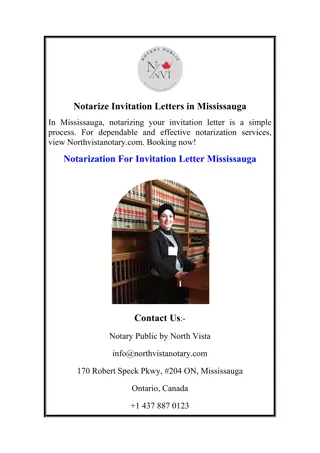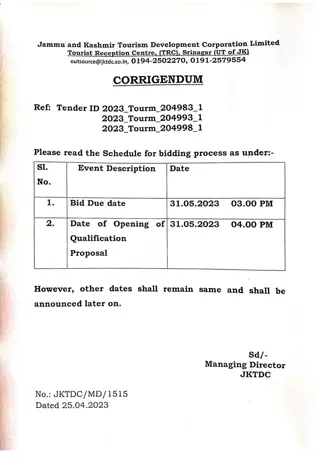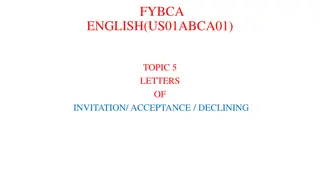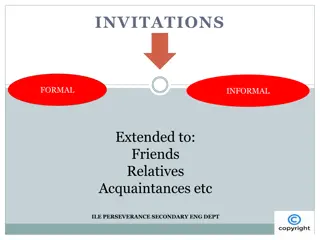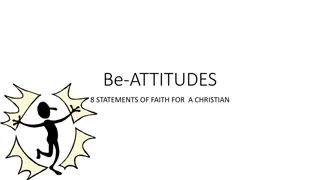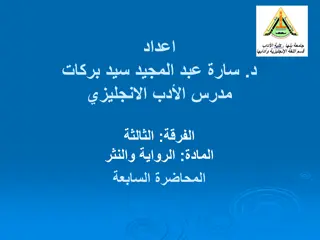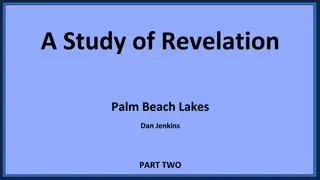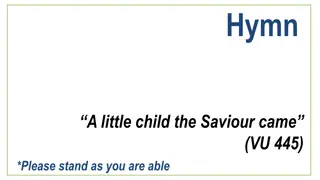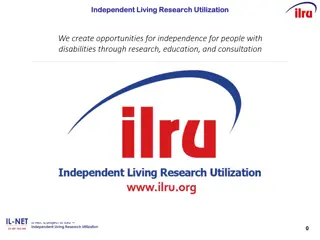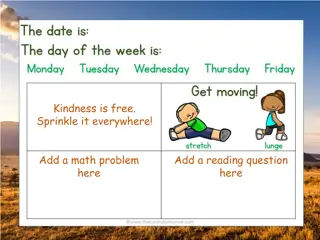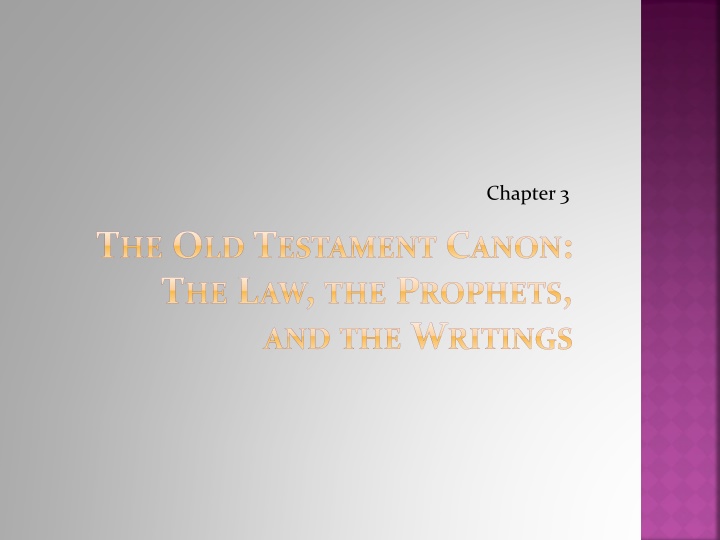
The Old Testament Canon: Law, Prophets, and Writings Structure
Explore the structure of the Old Testament Canon with a focus on the Law, Prophets, and Writings. Learn about the tripartite division, Hebrew and Greek orders, and the significance of each section in relation to the overall biblical narrative.
Download Presentation

Please find below an Image/Link to download the presentation.
The content on the website is provided AS IS for your information and personal use only. It may not be sold, licensed, or shared on other websites without obtaining consent from the author. If you encounter any issues during the download, it is possible that the publisher has removed the file from their server.
You are allowed to download the files provided on this website for personal or commercial use, subject to the condition that they are used lawfully. All files are the property of their respective owners.
The content on the website is provided AS IS for your information and personal use only. It may not be sold, licensed, or shared on other websites without obtaining consent from the author.
E N D
Presentation Transcript
Chapter 3 THE OLD TESTAMENT CANON: THE LAW, THE PROPHETS, AND THE WRITINGS
CHAPTER OUTLINE Introduction OT Canon The Law The Prophets The Writings Relation of OT Messianism to NT Conclusions
INTRODUCTION Canon is not a late imposition onto the OT documents Canon is inextricably linked with series of OT covenants Canon includes various types of documents: history, law, prophecy, wisdom, praise
OLD TESTAMENT CANON Tripartite structure Torah: making of a covenant between God & Israel Prophets: instructions & warnings re: covenant Writings: wisdom as well as historical works
OLD TESTAMENT CANON Hebrew order of canon: Torah (Law) Genesis, Exodus, Leviticus, Numbers, Deuteronomy Prophets Former Prophets: Joshua, Judges, Samuel, Kings Latter Prophets: Isaiah, Jeremiah, Ezekiel, the Twelve Writings: Wisdom: Psalms, Job, Proverbs, Ruth, Song of Songs, Ecclesiastes, Lamentations, Esther Histories: Daniel, Ezra-Nehemiah, Chronicles
OLD TESTAMENT CANON Greek order of canon: Pentateuch (Law) Genesis, Exodus, Leviticus, Numbers, Deuteronomy Historical Books Joshua, Judges, Ruth, 1-2 Samuel, 1-2 Kings, 1-2 Chronicles, Ezra-Nehemiah Poetic Books Psalms, Proverbs, Ecclesiastes, Song of Solomon, Job, Esther Prophetic Books The Twelve ( Minor Prophets ), Isaiah, Jeremiah, Lamentations, Ezekiel, Daniel ( Major Prophets )
LAW 5 book-structure Genesis structured around repeated genealogical formula (2:4; 5:1; 6:9; 11:27; etc.); a family history, patriarchal narratives Not everything in Torah is Law (Exodus 20 23; Leviticus; Numbers 1 9) Exodus Numbers: from Egypt to Sinai, from Sinai to Promised Land Read through lens of Deuteronomy (cf. Josh. 1:8: this Book of the Law ), set off sharply from preceding books
PROPHETS Former prophets Joshua, Judges, Samuel, Kings early prophets, become basis for later appeal to covenant loyalty Deborah (Judg. 4:4), Samuel (1 Sam. 3:20), Nathan (2 Sam. 7:2; 12:1), Gad (24:11), Ahijah (1 Kgs. 11:29) Latter prophets Isaiah, Jeremiah, Ezekiel, The Twelve Named after prophets (but little biographical information) Chronological scheme
WRITINGS Writings Wisdom Psalms, Job, Proverbs, Ruth, Song of Songs, Ecclesiastes, Lamentations, Esther 5 Megillot: Ruth, Song of Songs, Ecclesiastes, Lamentations, Esther Histories Daniel, Ezra-Nehemiah, Chronicles Connections with Torah (Law), Prophetic Books
OT MESSIANISM & THE NT A royal agent The servant of the Lord Revealed in the NT as the Lord Jesus Christ Caution against maximalist approach John 5:39: Moses writings one of witnesses to Jesus Luke 24:27: different parts of OT testify to Jesus 1 Peter 1:10 11: prophets had other functions, too Progressively developed in OT Line of Abraham, Jacob, prophet like Moses Descendant of David, servant of the Lord Christocentric vs. Christotelic
GUIDELINES FOR INTERPRETING THE OLD TESTAMENT CANON What is a passage s canonical position? What are its canonical neighbors? When a book has a different position in the Hebrew or Greek order, explore light shed on its contents by multiple canonical ordering. Explore how neighboring books act as conversation partners (e.g., Ruth with Judges, Proverbs, etc.). Explore various messianic strands in the Hebrew Scriptures.




